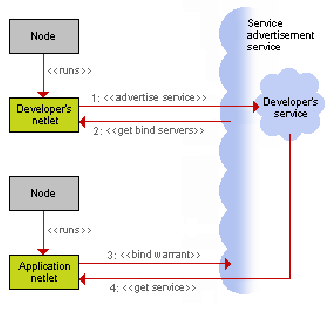A service advertisement service--a service which allows netlets to
be downloaded and hence allows service binding.
More correctly, it allows the downloading of netlet descriptors and
corresponding unsigned arguments. It may use the HTTP protocol, but
other options are possible which allow, for example, negotiation for
the most suitable netlet.
Since any netlet descriptor will probably contain references to the
JARs it needs (rather than containing the JARs themselves) a SAS will
most likely also deliver JAR files.
Figure:
Using a service advertisement service (SAS). (1) A developer uploads
their service to the SAS. (2) In return they get the URLs of bind
servers which they put into warrants for their service. (3) & (4)
A consumer netlet uses such a warrant to bind to the developer's service.
|

|
Access to a SAS is likely to be in three ways:
- The owner of the SAS will have administration access to it. They will
be able to create contracts with customers and issue them with user
warrants.
- A SAS user will use their warrant to upload netlet descriptors, unsigned
arguments and JAR files. With each upload they will get in return
a list of bind servers (i.e. URLs) where the uploaded items are now
available. They can then incorporate these bind servers into warrants
for their newly-uploaded service and pass on these warrants to their
service consumers.
- A service consumer will present a warrant to its node which will then
bind the service from the SAS. It will use the SAS because the warrant
lists the bind servers where the service is available.
See Figure ![[*]](crossref.png) for the second and third of these.
for the second and third of these.
See also: binding protocol.
Nik Silver
2001-11-21

![[*]](crossref.png) for the second and third of these.
for the second and third of these.